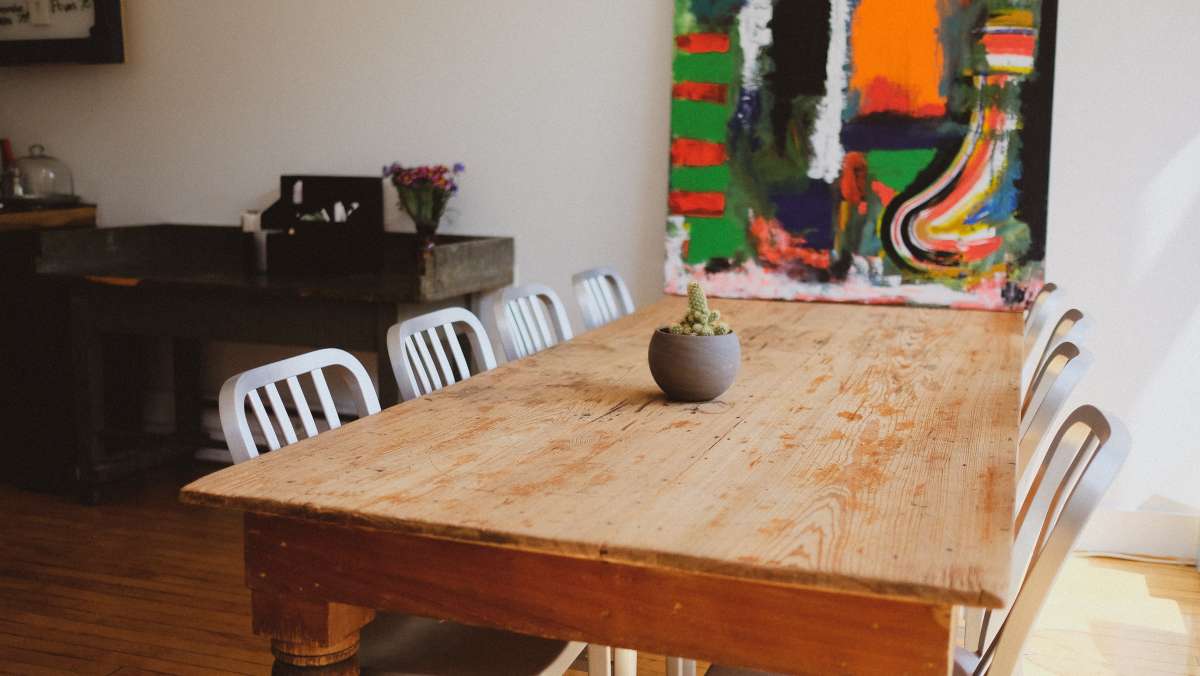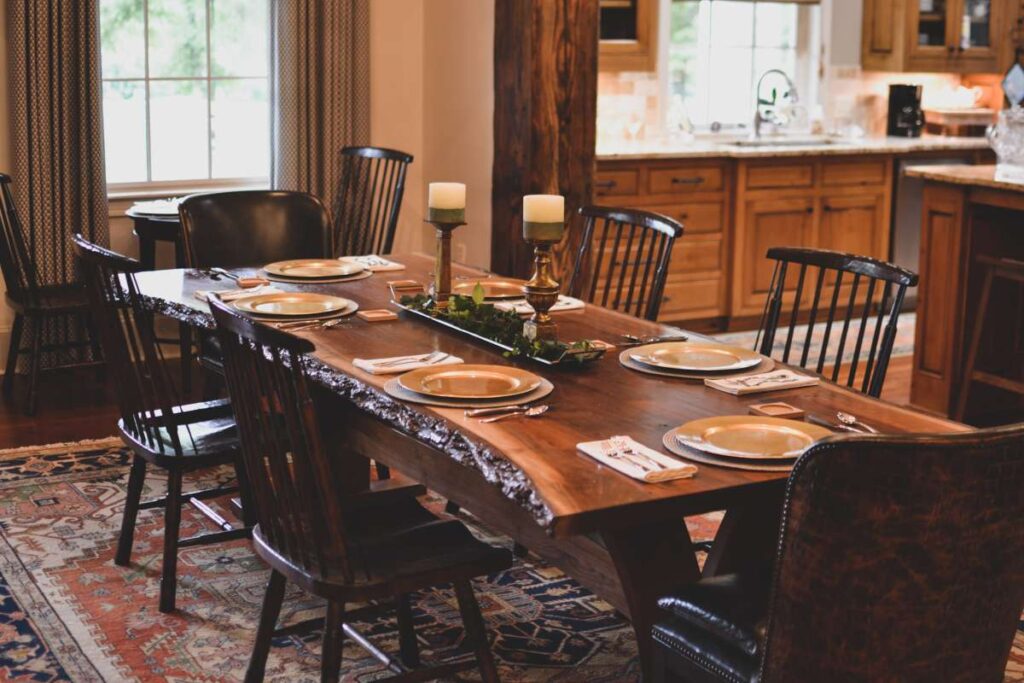Most homes have some wooden furniture in them. After all, it lasts a long time and can be found in many different hues and patterns.
The price and sentimental importance of the table played a major role in our decision to restore the wood.
Wood furniture restoration is a terrific DIY project for a rainy day because of the required labour. That's why it's important to know when something can be tossed and when it needs to be kept.
It's tempting to whip out your money and load up the vehicle with a beautiful piece of hardwood like this one.
Nevertheless, we don't often consider how much effort this could need.
That could be far more expensive than starting from scratch (in some cases). But, before deciding to refinish wood furniture, there are a few factors to consider.
Over time, exposure to sunshine and use can cause wood furniture to fade.
When people have wooden furniture, they frequently want to do anything they can to restore it to its former glory.
Refinishing is a worthwhile investment in some wood furniture but not in others.
To help you decide whether or not to refinish your wooden furniture, here is a tip on what to look for to evaluate whether or not it is worth it.
Should You Refinish Your Wooden Furniture?

Can Additional Glue Be Applied?
Depending on how old or damaged your piece of furniture is, it may be kept together with nothing more than glue.
Give your furniture a light rock to see if some seams give away if you're unsure how robust it is or if it needs strengthening.
A similar procedure can be used on the drawers or legs to pinpoint specific areas that need additional glue or screws.
To reinforce but instead glue a piece of furniture, you will need to disassemble it, apply glue, clamp it, and reassemble it.
A professional furniture assembly service can get the job done quickly and efficiently, saving you a lot of time and stress.
What Kind of Appearance Will It Have?
Hiring a professional furniture restorer is the best alternative if you want a flawless final product.
Attempting a project on your own is fine if you don't mind a less-than-perfect result.
This is especially true if the piece is destined for a less prominent location, such as a basement playroom or a child's bedroom.
If recovering a used chest of drawers is not done properly, flaws such as dents and scratches may reappear.
Is It Made of Good Materials?
Think about this first and foremost. High-quality wooden furniture will last for generations. Rare in today's furniture production, you might locate one in an antique shop or your grandmother's attic. Next, learn the rules and regulations for building.
Your item doesn't have to be an antique to be a fantastic example of old design and craftsmanship.
The item should have been made before 1950 at the latest and no later than 1960. Particle board plus laminate surfaces were introduced after this time to reduce costs and increase efficiency.
Even if it were mass-produced through an assembly process in the 1950s, the furniture would be considerably more robust and of greater quality than today's cheap furniture.
Even if your acquisition doesn't have much in antique worth, it could still be a fantastic vintage item that will serve you well for many years to come.
DIY refinishing can reduce the value of antique wood furniture, especially if it is from before 1850. Talk to a pro if you find a piece like this before beginning the job and know you want it.
Antiques
Items that are at least a century old are considered antiques. However, even if something has been around for a while and meets the definition of "antique," that doesn't mean it's valuable.
A trained practitioner should determine the value of conserving or restoring any item made before 1850.
It's not a good idea to attempt a DIY refinishing job on hundreds of years old furniture.
One possible exception to this rule but if the item has sentimental value to you that exceeds its monetary value.
If that's the case, restoring the pieces will allow you to choose a new stain or paint colour to complement your home's style.
Yet, wooden pieces from 1850 to 1960 can be refinished beautifully.
This is because, during that period, furniture was generally constructed better. To ensure the stability of the assembled wood, makers used dovetail and soft palate connections.
The methods used to construct wooden furniture were more sturdy and long-lasting than those used now.
In addition, plywood was replaced with solid wood on the backs of period pieces. The hardware on a piece of wood is another telltale sign of its antiquity.
You can safely begin refinishing your furniture if it bears any of these signs or a manufacturer's stamp.
To find the best lacquer or finish for your furniture, you should conduct some study.
Do You Paint Wood Furniture?
Check this out with your trained eye. You would exercise caution around anything painted, as there is generally a story behind the colour choice.
A piece of wooden furniture that had seen better days can have been refinished by having its flaws painted over.
The end effect may not be what you were hoping for if it turns out to be a cover for someone working two jobs.
Finding an item that smells musty, like old, dirty varnish that needs to be peeled off, is preferable.
Usually, you can see right through varnish to the underlying surface, so there shouldn't be any big shocks. It would be best to have a few tools and supplies from the hardware store, and it should come off without a hitch.
There is a greater likelihood that the underlying wood in your painted furniture is flawed.
Painting solid wood furniture isn't common unless the piece has defects in the wood's construction or finish.
Damaged or ugly wood furniture is rarely worth anyone's trouble and the work required to refinish it.
Varnish, used to complete wooden furniture, is coloured but again not opaque, revealing any imperfections previously hidden by paint.
Does It Need Re-gluing?
Up next. Try swaying the wooden furniture to see how stable it is. Try to open them, try closing drawers, rock them back and forth, sit on them, etc.
If the object is not stable, it must be disassembled and re-glued with the aid of clamps.
A professional woodworker should be consulted if you lack the necessary expertise or workshop space to complete the task.
Disassembling a wooden table, finding all the old glue, and starting over are difficult.
You can expect to pay a hefty sum to have a professional re-glue this part. A three-drawer chest, for instance, can easily set you back $350 to $400.
How Will It Look When Done?
It's hard to predict how the refinished wood furniture will look.
Find a hidden area of the piece where the original wood is still visible; this could be the back of something like a solid-wood drawer front, the top of a chest of drawers, or the underside of a table leaf.
Here you can see the grain and decide if you like it and if you can predict the final colour. For instance, the refinished colour of older wood is typically significantly deeper than that of freshly milled wood.
Be sure you like the look of the grain and know what colour you'll wind up with; ancient wood typically finishes significantly darker than freshly milled wood.
The following are some of the distinguishing features of several types of wood used in vintage furniture:
Walnut
Compared to cherry or maple, walnut has a far more vibrant grain. Hence, it is one of very few woods that can get lighter with age.
Because of its rich brown colour, the range of tones achieved with stain can be restricted.
Cherry
Cherry is a beautiful, versatile wood with a fine, even grain that takes stain beautifully.
But, if you strip a piece of furniture that is 100 years old, the restored wood will be quite dark.
Mahogany
People seem to either adore or despise mahogany.
A reddish hue will be released during the refinishing process regardless of your efforts.
It can start looking brownish red, but it will ultimately settle into a crimson hue. It's defining and singular, sophisticated and luxurious for some. Some people cannot fathom having it in their residence. What you do next is up to you.
Pine
Regardless of age, most pine would have been painted as soon as it was built.
As a result, it's unusual to come across one that has to be stripped and refinished. Honey-brown that's darker than young pine might be what you get, but who knows?
Maple
Maple furniture from the 1890s to the 1920s is typically a gorgeous bird's eyed or tiger sap with a uniform yellow hue after refinishing.
Stripped of its original 1960s orange-stained finish, plain maple can be updated with a light brown stain.
Oak
The majority of Victorian furniture was constructed from oak. Quarter-sawn oak with prominent flecking was a common material for "antique" furniture.
Refinishing this variety of oak wood furniture results in a stunning antique tiger oak grain that looks golden. Very regal!
Is Stripping and Repainting Really Worth It?

Your wood furniture may or may not be worth restoring, but only you can determine.
DIY projects are great if you're looking for a challenge or want to work on something with a friend or relative.
If you'd rather not deal with the difficulties above, a professional restorer may make your item look as good as new in no time.
How Challenging the Task Will Be
You should consider the difficulty of refinishing your solid hardwood furniture, even if it is not painted and is of good construction.
If the piece is a wooden room desk without many intricate carvings or other details, refinishing it could be a good idea.
If you don't have much experience refinishing wood and have a more complicated piece, it's probably best to hire a professional.
This will ensure the task is completed properly and the object is not damaged.
If you're a do-it-yourselfer who cares only about the final product, restoring a piece of hardwood to like-new condition isn't the project for you.
Just keep an eye out for these warning indicators that indicate you could need more time, more complicated methods, or an expert's assistance with your job.
- Slats or spindles in this artwork are closely spaced.
- Further applications may be required for some components.
- Several boards from different trees were used to construct it.
- Detailed filigree carvings or applications adorn it.
Take into account the time and effort that will be required to bring the object back to its former splendour.
Some of the following may indicate that you need to take your project to the next level:
Filigree is either intricately carved or meticulously applied. The process of removing the old finish from every crevice and then applying a new one can be tedious and time-consuming.
Further applications are required in various spots throughout the piece.
A chair with decorative side slats or slats may require a light hand on the decorative areas but several coats of polyurethane on the arms for durability.
It's made up of closely spaced slats or spindles. You'd need a spray gun to remove that and apply a new finish.
It's a jumble of planks from different trees.
That's one of the unpleasant revelations that can follow a strip search.
You can accept it as-is or put in a lot of work staining it to look homogeneous. However, that seems like a rather involved finishing procedure.
In conclusion, it is best to seek the assistance of an expert if you are unsure of what you are dealing with. Also, don't overextend yourself just because something looks promising.
Guidelines for Wooden Furniture Refinishing
Medium-density fibreboard is abbreviated as MDF. In other words, medium-density fibreboard (MDF) is a synthetic wood that is more durable than real wood.
It is more cost-effective for producers and has a higher tolerance for temperature and humidity swings.
In the furniture industry, MDF is sometimes coated with a wood laminate, which is effectively an image of wood.
As we've already established, refinishing wood furniture is best done during a specific era of furniture manufacturing.
That's because, starting around 1960, factories started skimping on quality control. As a result, glue and nails have replaced dovetail joints, and solid wood has been swapped out for MDF.
The majority of mass-market furniture is made of MDF. We suggest getting a new piece of furniture if that's the case.
Send a tiny, concealed section of your table for analysis to determine if it is made of natural wood.
You can tell it's fake wood if the wood underneath doesn't match the grain exactly.
Use these wood refinishing guidelines as a checklist to decide if your furniture is worthy of a new coat of paint.
The typical weekend is plenty of time to complete most refurbishing tasks. But, Guardsman has your back if you are dubious about your refinishing abilities or would rather have a professional handle the task.
FAQs About Wood Furniture
It's no exaggeration to say that figured Otway blackwood is Australia's premier furniture wood. Similar to Tasmanian blackwood, although typically much paler in tone. Golden blackwood, or Victorian blackwood, are other names for this wood.
Because solid wood construction materials haven't been engineered or made from the scraps of other components that they are considerably more expensive, especially when you start to talk about larger dimensions – the kinds you'll need to build tables, bookcases, desks, and more
Jarrah is most expensive than the other forms of Engineered timbers, but it's beautiful color that vary from light to very dark reds and brown makes it the most popular choice. Jarrah turns grey when left unsealed and its durability range is 2 which make it fire resistant and you can place it in the fire prone areas.
The most common species in Australia is eucalyptus. Within the species there are a huge variety of sub-species that have vary different properties, including colour and grain patterns. Common ones include Tasmanian Oak (cream), blackbutt (pale brown), spotted gum (mid brown) and Jarrah (red).
Quality wood furniture is stronger than furniture that comes packed flat in a box, and it will last for years. It'll also look much better for much longer than cheaply-made furniture, like the kind that consists of a thin veneer of hardwood affixed to a lighter and less expensive wood like plywood.

